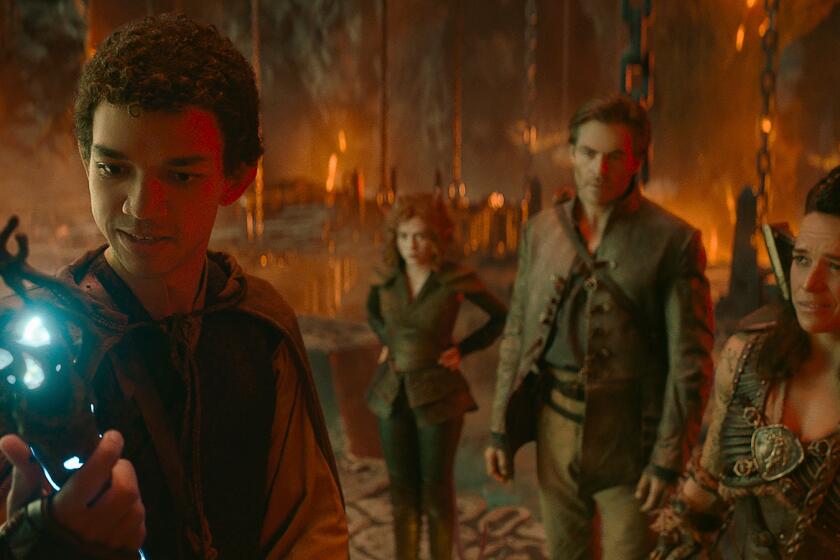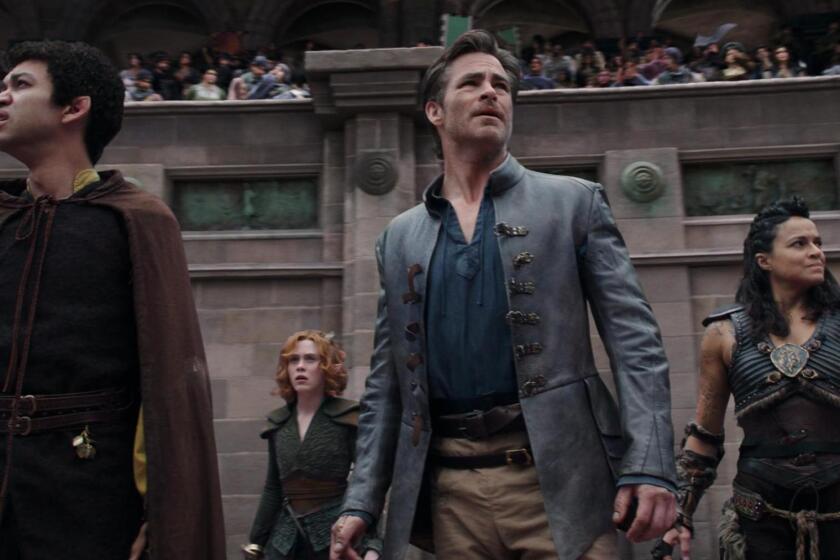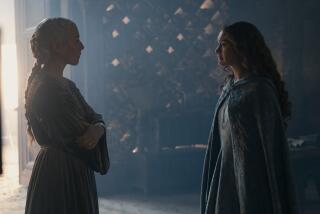Why is ‘Dungeons & Dragons’ so beloved? One scene in the movie captures it perfectly
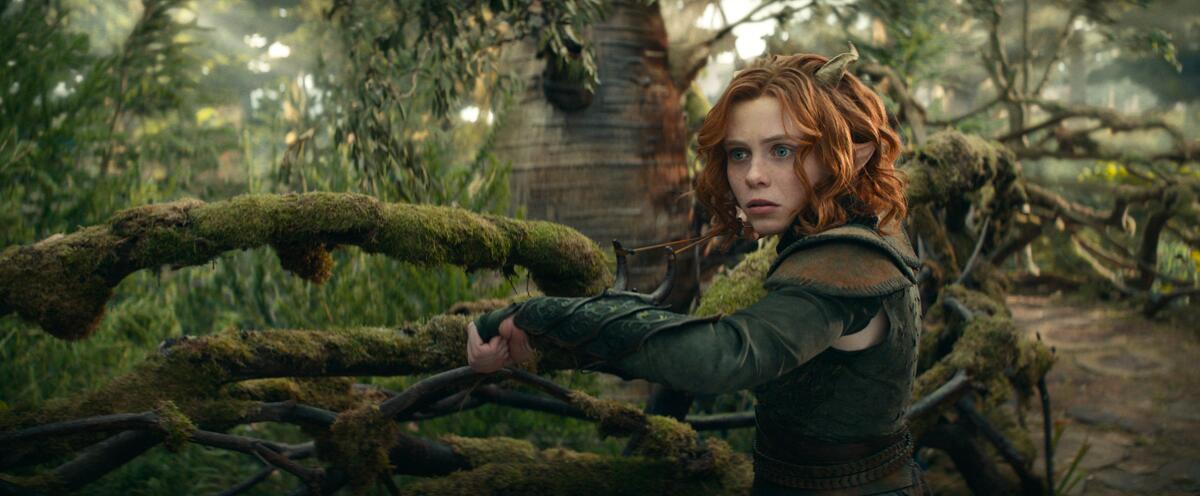
- Share via
This story contains light spoilers for “Dungeons & Dragons: Honor Among Thieves.”
In “Dungeons & Dragons: Honor Among Thieves,” a bard, a barbarian, a sorcerer and a druid team up to pull off their biggest heist yet — and also save the world.
Much like in an adventure in the tabletop role-playing game on which the film is based, “Dungeon & Dragons,” in theaters Friday, sees its heroes journey across the land on a series of missions to help them on their overall quest: to take down a certain traitorous rogue. And like any good dungeon master, directors Jonathan Goldstein and John Francis Daley, who also wrote the film’s script with Michael Gilio, make sure each member of the party has moments to showcase their individual talents.
The tabletop D&D creates a set of guidelines in which players can let their imaginations fly, and Goldstein and Daley sought to channel that experience in the film set within the fantasy world of Dungeons & Dragons rather than directly adapting any existing story.
“We wanted to make sure the movie captured that spontaneity, the collaboration, the unpredictability, and that need to kind of pivot when things turn against you, as they inevitably do,” said Goldstein during a recent video call.
‘Dungeons & Dragons: Honor Among Thieves’ leans on stars Chris Pine, Michelle Rodriguez and Hugh Grant to do what they do best.
“The thing that’s so exciting to me about doing a D&D movie is you can add that element of levity and whimsy to the film without at all betraying the lore,” added Daley, who noted that playful irreverence is part of the game’s experience. “That sense of heartfelt-ness and the lack of cynicism was really important to us … And I think that there’s a way to be humorous without at all undermining the stakes, or the sincerity” of the adventure.
One standout sequence that encapsulates the spirit of the film involves the tiefling druid Doric, played by Sophia Lillis. After reluctantly agreeing to join Edgin (Chris Pine), Holga (Michelle Rodriguez) and Simon’s (Justice Smith) party, Doric sneaks into a castle to gather some intel as a literal fly on the wall. Unfortunately, her spying is noticed by the Red Wizard Sofina (Daisy Head), prompting a chase where the camera follows Doric in one, long, seemingly uninterrupted take as she tries to make her escape while shape-shifting into a number of different creatures.
It’s a sequence Goldstein and Daley pitched at their very first meeting with Paramount for “Dungeons & Dragons.”
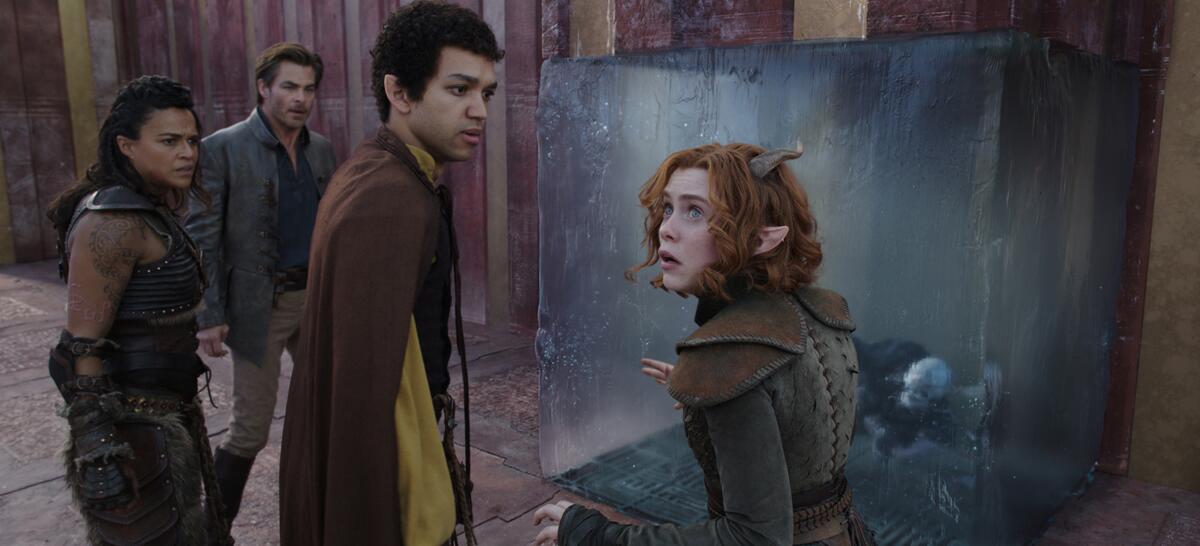
Abandoned by her human parents for being a tiefling — someone of human lineage who inherited demonic traits thanks to some act by an ancestor — Doric is wary of humans, and also doesn’t quite fit in with the druidic community that has taken her in, the Emerald Enclave.
To prepare for the role, Lillis said she “watched a lot of animal documentaries” to study their movements closely, from the muscles they use to their centers of gravity. This is because, as a druid, Doric has an ability to shape-shift into beasts known as Wild Shape.
“I’ve always thought movement [and] how to use your body is a very important skill to have when you’re acting,” said Lillis. She put it to use as Doric, in particular during her transitions into animal form; the stunt team also incorporated animal-like moves into Doric’s fighting style, she said.
‘Dungeons & Dragons: Honor Among Thieves’ launches the SXSW Film Festival and is the latest attempt to adapt the popular role playing game. Earlier films have been poorly received, but the latest lands at a time when the game is enjoying a renaissance.
Doric’s most impressive transformation is into an owlbear, a fierce, feathered monster with the head of an owl and the build and body of a bear. A druid technically wouldn’t be allowed to shape-shift into an owlbear under current D&D rules, but Daley cited the “Rule of Cool” — which allows dungeon masters to ignore some rules for the sake of the story — as their justification.
“She may seem kind of reserved and doesn’t say a lot within the context of the group, but [Doric is] her most free when she’s these other animals, especially the owlbear,” said Daley. “She kind of is most comfortable in her own skin when she’s these other creatures.”
While Doric does not transform into an owlbear during her big escape sequence, she does Wild Shape into six different creatures over the course of the chase: a fly, a mouse, a bird, a cat, a deer and an Axe Beak — a fictional, tall, flightless bird unique to D&D, its movements here based on ostriches.
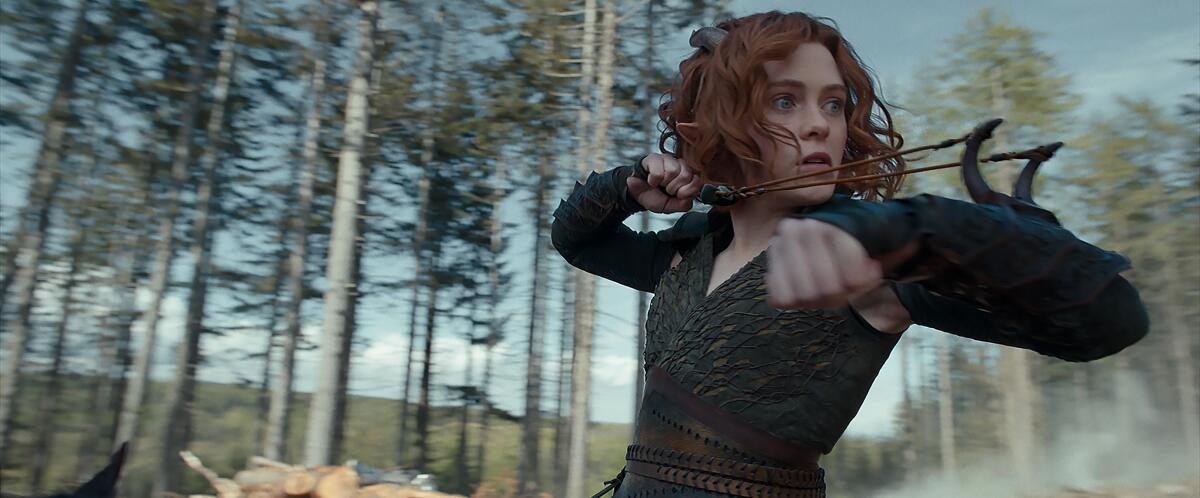
Admittedly, one-take sequences “are not easy to do” according to the directors, who got a taste for them after including one in 2018’s “Game Night.”
One of the challenges for a single long shot, explained the film’s production visual-effects supervisor, Ben Snow, is “How do we break that up into filmable segments? And how do we spot where the blends are going to be between those different segments?”
Preparation for the sequence included storyboards and a rough animation during the previsualization stage — which allowed the team to notice “that you kind of lost your connection to Doric herself” in the initial version, said Snow. “So we changed it so she changed back into herself more.”
In the final version of the sequence, Doric shifts back into her tiefling form twice, once into a suit of armor after running around as a mouse and another after a brief transformation into a cat.
Despite the complexity of the scenes, which risked falling into the “uncanny valley” during Doric’s transitions, one of the most complicated shots centered on a seemingly simply movement: Doric back in her tiefling form after having been a cat, trying to pull a hood up over her head before walking out into the busy streets of the town. The hood kept getting stuck in her horns.
“Oh, God,” said Lillis. “I don’t know why it was so hard. [The hood] was flimsy, and the material was weird, and it was sort of windy. It took the entire day.”
Indeed, the majority of the sequence was shot on physical sets using as many practical effects as possible.
“Part of what attracted me to visual effects was the magic trick aspect of it,” said Snow. “A lot of directors have a desire to try to keep things as real as possible … so I kind of like solving problems like this, where [we figure out] how we can keep it real for as much as we can, and then use CG where we can’t possibly use it real.”
The chase sequence starts, for instance, in the set of the vault room with a computer-generated fly version of Doric. The crew cut a hole in the wall of that set to pull the camera back through it, leading the digital fly before becoming a fully computer-animated scene within the wall. Similarly, the sets used for the portion of the chase where Doric is a mouse were built with a removable floor to allow the camera to get low enough to capture the necessary angles.
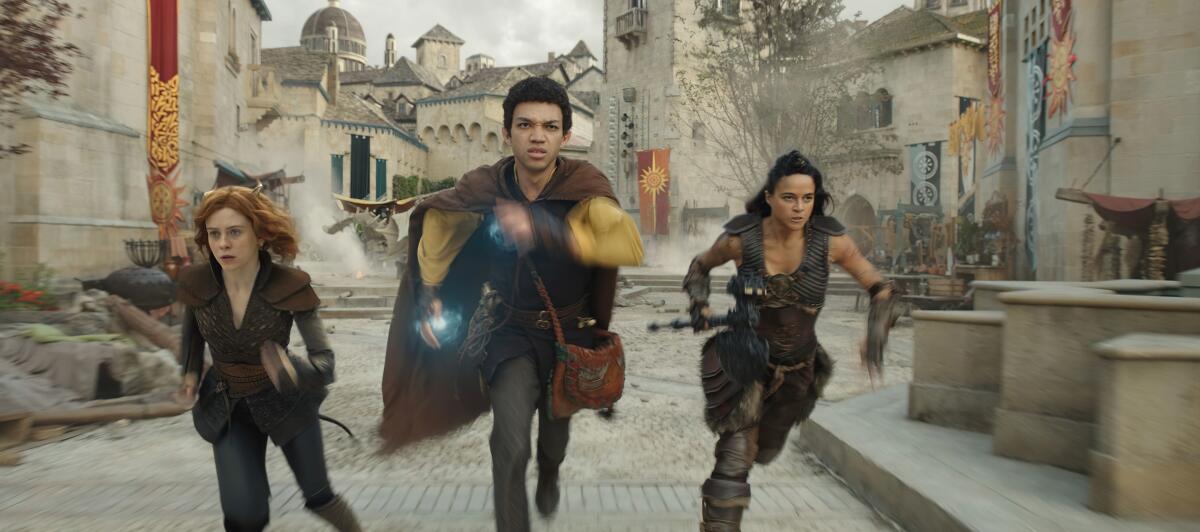
And while most of the animals were digitally rendered, including Doric’s bird form that falls down a chimney after crashing into a flag, the cat that walks out of the chimney was real.
“We filmed several takes,” said Snow. “I got to direct the cat.”
Other practical elements include the explosion in the grain room (which resulted in popcorn) and the pyrotechnics used to blow up an aqueduct (which did not work the first time and took a month to rebuild to shoot again). With the amount of effects the sequence entailed, it was the last VFX shot to get finalized.
As audacious as it is, though, the sequence — which came together thanks to the work of VFX artists from the Moving Picture Company, with some assistance from Industrial Light & Magic — might have been even grander. A shot of an actual dog, meant to be shown reacting to Doric’s cat form, was deemed “kind of cheesy,” according to Daley, and a moment in which mouse Doric scampered through a dining room filled with guards was lost along the way too.
“We decided,” Goldstein said, “that it was one beat too many.”
More to Read
Only good movies
Get the Indie Focus newsletter, Mark Olsen's weekly guide to the world of cinema.
You may occasionally receive promotional content from the Los Angeles Times.
